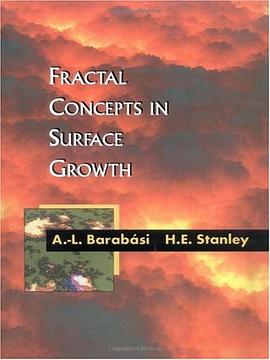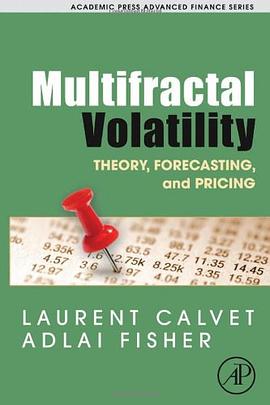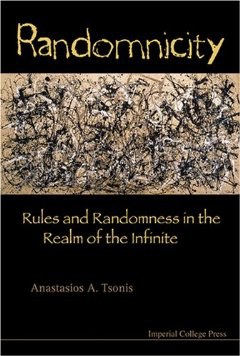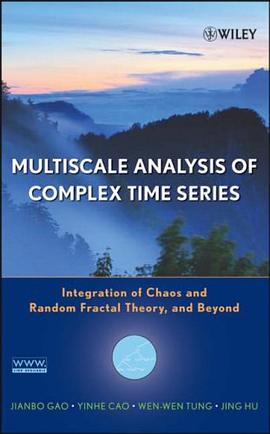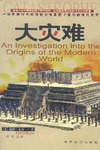

具体描述
本书是国内也是国际第一本分形几何在流体中的应用的参考书。本书介绍的方法不仅可以用于流体, 还可以用于其他任何有关连续随机的运动轨迹的模拟,用于粒子云的随机散布轨迹。
本书是瞿波博士在英国的博士学位论文的核心成果。书中深入浅出地介绍了分形及其在流体中的应用。详细论述了如何用分形中的分数布朗运动(fBm)模拟流水中污染物的轨迹,包括对海湾和海洋中的污染物传播轨迹的模拟。
书中介绍的方法是基于分数布朗运动(fBm), 这是带有记忆的著名的布朗运动(随机散步)的推广。 作者对著名的fBm作了改进,创建了分数布朗运动粒子跟踪模型,并推广到加速分数布朗运动粒子跟踪模型。基于豪斯特指数(H)的灵活性,分数布朗运动粒子追踪模型的应用非常广泛。可以用于经融、股市、脑电图、岩石的裂缝,道路的分布、海洋的浮标轨迹、粒子的散布、医学上人体肺的分布及毛细胞血管、脑电图曲线(图14)等具有分形的特征物体和现象中。
本书的第一部分介绍了分形。不同于其他书介绍分形时所用的复杂的数学工具,使人望而生畏,书中介绍的分形及分形维数的计算都是用最通俗易懂的方法。这是一本实用性强、浅显易懂的应用数学学习和研究参考用书。书中还附有程序供直接使用。相信此书对大学生、研究生、大学青年教师搞科研有一定的实用和参考价值。
作者简介
瞿波 博士
江苏南通人。
1983年华东师范大学数学学士。
1986年华东师范大学数学硕士。
1992年赴英国在爱丁堡龙比亚大学(Edingburgh, Napier University)攻读计算机硕士课程和流体力学博士学位。研究方向是分形在流体中的应用。1999年获英国博士学位(PhD degree)。
1999年英国贝尔法斯特女王大学(Queen’s University of Belfast)研究助理。
2000年香港大学(Hong Kong University)土木工程系博士后。
2003年澳大利亚格里菲里斯大学(Griffith University)研究员。
2008年回国,在南通大学任教。硕士生导师。承担国家自然科学基金(2012年度)“北极的生态系统和二甲基硫对当地气候的影响”等多项课题研究。
20年来致力于分形在流体力学中的应用研究,以及环境模型,水利模型等国际国内课题研究。热衷于数学分形的普及推广,有多项成果在《国际流体数值方法》、《极地生物学》等国际权威杂志发表。
目录信息
自序
分形几何介绍(只需要初等数学的知识)
博士论文
The Use of Fractional Brownian Motion in the Modelling of the Dispersion
of Contaminants in Fluids
Chapter 1: Outline of Project 1
1.1 Introduction 1
1.2 Fractal and Fractional Brownian Motion 1
1.3 Aim and Objectives 2
1.4 Structure of Thesis 3
Chapter 2: Diffusion and Dispersion in Fluids
-- A Literature Review 4
2.1 Introduction 4
2.2 Molecular Diffusion: Fick’s Law and the Diffusion
Equation 5
2.3 Statistical Theory of Diffusion: Brownian Motion 8
2.4 Turbulent Diffusion 11
2.4.1 Introduction 11
2.4.2 Eddies 12
2.4.3 Taylor’s Theorem 13
2.4.4 The Relationship Between Lagrangian and
Eulerian Measurement 15
2.4.5 Relative Diffusion and Richardson’s Law 17
2.4.6 Okubo’s Oceanic Diffusion Diagrams 19
2.5 Shear Dispersion 22
2.5.1 Introduction 22
2.5.2 Taylor and Elder’s Shear Dispersion Results 22
2.5.3 Dispersion in Rivers 24
2.5.3.1 Dispersion in Uniform Depth Open Channel 25
2.5.3.2 The Three-Dimensional Diffusion
Coefficients in an Open Channel 28
2.5.3.3 Dispersion in a Natural Channel 30
2.5.4 Dispersion in the Sea 31
2.5.4.1 Introduction 31
2.5.4.2 Relative Diffusion on the Ocean Surface 32
2.5.4.3 Coastal Region 36
2.6 Numerical Model of Dispersion 38
2.6.1 Solution of the Advection-Diffusion Equation 38
2.6.2 The Disadvantage of Solving the
Advection-Diffusion Equation 40
2.7 Particle Tracking Methods 42
2.7.1 Traditional Particle Tracking Methods 42
2.8 Summary 46
Chapter 3 Brownian Motion, Fractional Brownian Motion
and Fractal Geometry 47
3.1 Brownian Motion 47 3.1.1 The Definition of Brownian Motion 47 3.1.2 Two Simple Random Walks 48 3.1.3 Brownian Motion Generation 51
3.1.3.1 Central Limit Theorem Method 52
3.1.3.2 The Box-Muller Method 53 3.1.4 The Properties of a One-Dimensional
Brownian Motion Time Trace 54
3.1.5 The Skewness and Kurtosis of Random Walks 57 3.1.6 Random Walks in Two Dimensions 59
3.1.6.1 Delta Random Walks in Two Dimensions 60
3.1.6.2 Constant Random Walks in Two
Dimensions 60
3.1.6.3 Brownian Motion in Two Dimensions 61 3.1.7 The Last Steps of the Random Walks in Two
Dimensions 62
3.2- Fractional Brownian Motion 63
3.2.1 Introduction 63 3.2.1.1 Fractional Brownian Motion:
A Generalisation of Brownian Motion 63
3.2.1.2 Applications of Fractal Brownian Motion 64
3.2.1.3 The Definition of Fractional Brownian
Motion 67
3.2.1.4 Properties of Fractional Brownain Motion 68 3.2.1.5 Methods for the Generation of Fractional
Brownian Motion 70
3.2.2 FBM Model 71 3.2.3 FBMINC Model 76 3.2.4 The Comparison of the FBM and FBMINC Models 80
3.2.5 fBm Plots in One Dimension 85 3.2.5.1 Fractional Random Walk Plots for the
FBM Model 85
3.2.5.2 The Effect of the Different Random
Number Sequences 89 3.2.5.3 The Mean Absolute Separation of an
fBm Trace 90 3.2.6 The Relationship Between M, NSTEP and P 92 3.2.6.1 Relationship Between NSTEP and M 92
3.2.6.2 The Effect of the Number of Particles
in a Diffusing Cloud 94
3.2.6.3- A Check on Random Number Seeds 95 3.2.7 Fractional Brownian Motion in Two Dimensions 96
3.2.8 Projection of Two-Dimensional Fractional Brownian
Motion 98
3.2.9 The Use of Simpler Probability Distributions to
Reduce CPU Time 100
3.2.10 Long Term Fickian Behaviour 104 3.3 fBm as a Random Fractal Function 106
3.3.1 Fractal Geometry and Fractal Curves 106
3.3.2 Fractal Dimension 109 3.3.3 Fractal Properties of fBm 110
3.3.3.1 The Box Counting Dimension 111
3.3.3.2 The Dimension of an fBm Trace 111
3.3.3.3 The Dimension of fBm Trajectories 113
3.3.4 Method for Determining H from Real Data 116
3.4- Summary 121
Chapter 4 Coastal Bay Modelling 122
4.1 Introduction 122
4.2 New Particle Tracking Method Using in the Bay 122
4.2.1 Advection 123
4.2.2 Diffusion 124
4.2.2.1 Traditional Random Walk Model 124
4.2.2.2 Diffusion Using Fractional Brownian
Motion Model 125
4.2.2.3 The New fBm Particle Tracking Model 127
4.2.3 Choosing a Time Interval 128
4.2.4 Choosing a Diffusion Coefficient 129
4.2.5 Boundary Reflection 131
4.2.5.1 important Note on FBM Reflection 133
4.2.6 The Particle Tracking Model 133
4.2.6.1 The Particle Tracking Algorithm 133
4.2.6.2 Typical Particle Trajectory Plots for the
Bay Model 136
4.2.7 Particles Clouds 137
4.2.7.1 Computational Effort 137
4.2.8 Concentration Calculation and Plots 139
4.2.8.1 Algorithm for Calculation of Pollution
Concentration 140
4.2.8.2 Contour Plots and 3D Surface Plots 141
4.2.9 Further Reported Results 142
4.3 Shear Dispersion 143
4.3.1 Simple Shear Dispersion (Brownian Motion) 144
4.3.2 Shear Dispersion with Fractional Brownian Motion 147
4.3.3 Shear Dispersion in the Coastal Bay Model
Recirculation Zone 150
4.4 Summary 153
Chapter 5 Simulation of Observed Coastal Dispersion 189
5.1 Introduction 189
5.2 Northumbrian Coastal Water Data Sets 190
5.3 Three Methods for Calculating the Standard Deviation of
the Dye Patch Concentrations 191
5.3.1 The SQ-Method 192
5.3.2 The R-Method 193
5.3.3 The SR-Method 194
5.3.4 Estimation of the Direction of the Mean Advective
Velocity Vector for Each Patch 194
5.4 Comparison of the Three Methods 195
5.4.1 The Reason for Introducing the SR-Method 195
5.4.2 Comparison of the Results Using the Three
Methods 196
5.5 Accuracy of the Results 197
5.5.1 The Sensitivity of the Centre 197
5.5.2 The Concentration Function Calculation 198
5.6 Simulation of the Observed Dye Patches Using an fBm
Based Particle Tracking Model 198
5.6.1 The Accelerated Fractional Brownian Motion
(AFBM) Model 199
5.6.2 Simulation Using the FBMINC and AFBM
Models 202
5.6.3 Concentration Calculations 202
5.6.4 Contour Plots 203
5.7 Summary 205
Chapter 6 Conclusions, Discussion and Recommendations 243
6.1 Introduction 243
6.2 Achievement of Objectives 243
6.3 Discussion 247
6.4 Recommendations for Future Work 249
Appendix 1 FORTRAN 77 Programs 253
References 293
分形应用论文选
1. 分数布朗运动的简化和应用 317
2. 从分形维数到海洋表面漂浮物轨迹的模拟 328
3. 流体中污染物扩散的分形模拟 335
4. 用分数型布朗运动模拟海湾的剪切湍流分散 343
5. Development of FBMINC model for particle diffusion
in fluids 354
7 加速分数型布朗运动粒子追踪模型在水面污染扩散中的应用 387
· · · · · · (收起)
读后感
评分
评分
评分
评分
用户评价
写得浅显接地,但后面看了作者发的论文,几篇都是大同小异,略失望
评分写得浅显接地,但后面看了作者发的论文,几篇都是大同小异,略失望
评分写得浅显接地,但后面看了作者发的论文,几篇都是大同小异,略失望
评分写得浅显接地,但后面看了作者发的论文,几篇都是大同小异,略失望
评分写得浅显接地,但后面看了作者发的论文,几篇都是大同小异,略失望
相关图书
本站所有内容均为互联网搜索引擎提供的公开搜索信息,本站不存储任何数据与内容,任何内容与数据均与本站无关,如有需要请联系相关搜索引擎包括但不限于百度,google,bing,sogou 等
© 2025 book.quotespace.org All Rights Reserved. 小美书屋 版权所有


